Read Reviews
The Best Compost Bins
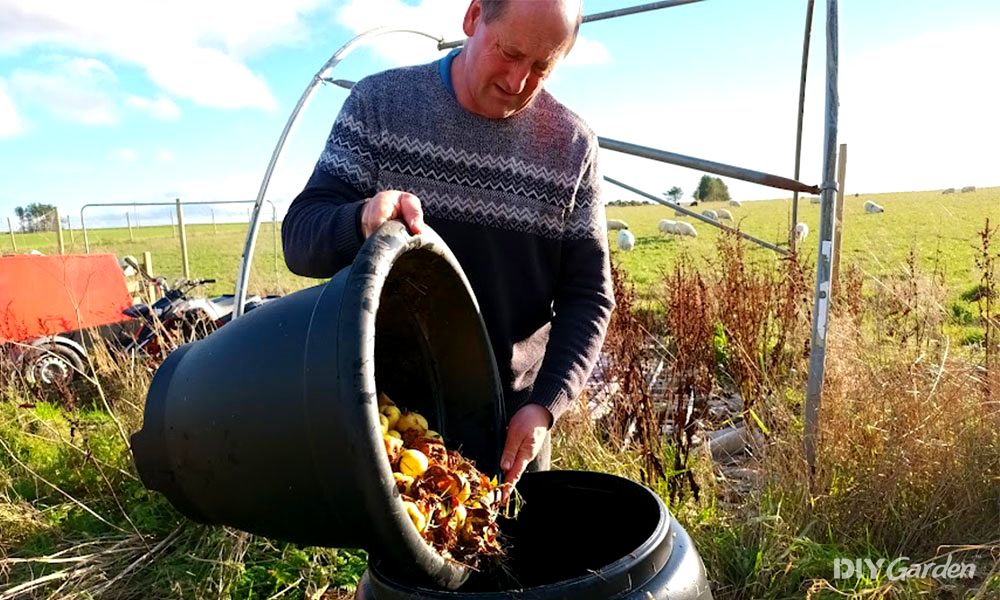
-
Best compost tumbler - Garden Point Dual Chamber Tumbling Composter Bin
-
Best traditional compost bin - Blackwall Compost Bin
-
Best value compost bin - 4smile Garden Compost Bin
-
Best compost bin for leaves - GR8 Garden Metal Wire Mesh Compost Bin
-
Best wooden compost bin - Easipet Wooden Compost Bin
Compost Bin Reviews
1. Garden Point Dual Chamber Tumbling Composter Bin
Best compost tumbler
- No need to manually turn compost as the drums can spin
- Well-sealed and raised off the ground, making this rodent-proof design ideal for kitchen waste
- Comes with two 70 litre composting chambers, giving you a second one to use once the first one is full
- The sliding doors are useful - you won’t have to deal with the door swinging shut while you’re trying to fill the bin
- Has plenty of small holes for ventilation to help aerate the compost
- Assembly can require some force
- May not be big enough for bulk amounts of garden waste because drum chamber is quite small and so are the doors
- Capacity
- 140 L
- Shape
- Hexagonal
- Assembly
- Yes
- Assembly Ease
- 4.5
- Design
- 5
- Ease of Use
- 5
- Value for Money
- 5
If you find the process of turning compost taxing, the Garden Point Dual Chamber Tumbling Composter Bin will immediately appeal to you. This innovative compost bin stands out from the rest – not only in terms of appearance, but also when it comes to features.
Although there are a fair amount of pieces to put together, assembly only took me about 20 minutes. I did have to use quite a bit of force when connecting the panels though; something to bear in mind if you struggle with hand strength.
Once assembled, I was left with a beautifully-designed compost bin with two plastic drums, each capable of holding 70 litres of material. A steel axel runs through the middle, allowing you to spin the drums and turn the compost.
There are many tumbling composters out there with just one drum, but having two is a real benefit. When the first is full, you can start filling the second whilst the material in the first breaks down.
There are ventilation holes in both drums. They’re large enough to let air through, but small enough to keep rodents out.
As I expected, this compost bin was easy and convenient to use. It’s a bit too small for bulk amounts of garden waste, because the barrels and doors are a little small, but it’s perfect for kitchen scraps.
The sliding doors are easy to open and the tumbling mechanism is very useful, making it quick to turn compost.
Understandably, some may be put off by the price of this compost bin; however, I personally think it’s great value for money, even though it’s more expensive than standard bins. This model offers so much more in terms of convenience. It’s also a quality product – it may be a plastic compost bin, but it feels strong and sturdy, rather than cheap and flimsy.
Overall, I couldn’t have been more impressed with this option and it’s the best compost bin that I tested. There’s nothing about its design that I would change, but if you’re searching for a large compost bin then you’ll probably be better off with a different model.
However, if you only plan on adding small amounts of food waste, or want somewhere secure to empty your food waste caddy, then the Garden Point Dual Chamber Composting Tumbler is, in my opinion, the best option out there.
Did you find this review helpful?
2. Blackwall Compost Bin[ SAVE 3% ]
Best traditional compost bin
- A capacity of 220 or 330 litres makes this bin suitable for both small and large gardens
- Made from strong, flexible, and recycled plastic - much stronger than some of the other plastic compost bins out there and a more eco-friendly option
- Removable lid means that the bin can be filled from every angle
- Removable front hatch clicks in and out easily, which should make it easy and convenient to access the finished compost
- Comes ready to use - no assembly required
- The lid isn’t windproof like it claims - a strong gust will send it flying and it can’t be locked into place
- The bin itself isn’t windproof and there is no way to peg it to the ground so it can’t be placed in exposed, windy areas
- The top opening of the bin is slightly on the small side, but not so much as to be a big inconvenience
- Capacity
- 220 L or 330 L
- Shape
- Cone
- Assembly
- No
- Assembly Ease
- 5
- Design
- 4.5
- Ease of Use
- 5
- Value for Money
- 4
If you browse through the many different compost bins available online, you’ll see several that look just like the Blackwall Composter. It has a classic, popular design, so I was eager to put it to the test on my farm.
As soon as I unwrapped this compost bin, I was instantly delighted. Why? Because it’s the only one out of the five I tested that didn’t require any assembly whatsoever. Easy!
It has a conical shape, which gives it a sturdy feel. This is helped by the fact that the plastic is both strong and flexible. Even better, the plastic is actually made from recycled materials. As a result, it’s a more eco-friendly option, easing some of the guilt about buying new plastic products for your garden.
The bin has a capacity of 220 litres. It has a removable lid and front hatch, and comes without a base, which makes it ideal for placing onto soil or grass.
I found this compost bin a lot easier to use than some of the others that I tested. The removable lid means that you can fill it from every angle, and the robust plastic stands strong when it’s hit with a garden fork.
One of the only flaws in the design is that the bin opening is pretty small. It would have benefitted from being larger – not only to make filling the bin easier, but also turning the contents. However, this wasn’t a major issue, more a minor niggle.
Although this is a plastic compost bin, it’s priced marginally higher than many others. When you consider the strength of the plastic, and the fact that it won’t break as easily as some of the others out there, it seems reasonable to pay a little extra.
However, if you live in an exposed and windy area, I would recommend choosing another model. Although this one is supposedly windproof, it flies off around my farm at every given opportunity, and there isn’t really an effective way to peg it down (or even lock the lid in place for that matter!). Nevertheless, if you’re able to keep it sheltered from the wind, then you shouldn’t have any problems.
Buying plastic compost bins can be a bit of a hit-or-miss experience – some are cheap and flimsy, while others are well-made and durable. The Blackwall Composter fits into the latter category. As long as it doesn’t have to deal with strong winds, it’s sturdy, well-designed, and easy to use. It’s also one of the best compost bins to go for if you don’t want to mess around with assembly, and want a more eco-friendly plastic option.
Did you find this review helpful?
3. 4smile Garden Compost Bin
Best value compost bin
- Easy to assemble with no tools required
- Lightweight enough to be moved around a garden
- Sturdy enough to withstand very strong winds
- 300 litre capacity is suitable for both small and large gardens
- Has a removable hatch at the bottom to allow for easy access to the finished compost
- Straight, square edges mean that this bin can be neatly lined up next to others
- The plastic that this bin is made from is very brittle (rather than hard and flexible), so can break easily during assembly
- Due to thinner plastic, it wouldn’t be difficult to pierce through the side with a fork whilst turning the compost
- The lid can’t be propped up or removed, so it needs to be held open with one hand while you’re filling the bin
- Capacity
- 300 L
- Shape
- Rectangular
- Assembly
- Yes
- Assembly Ease
- 5
- Design
- 4
- Ease of Use
- 3
- Value for Money
- 4.5
Designed to hold both kitchen and garden waste, the 4smile Garden Compost Bin looks like a pretty traditional compost bin at first. However, there are a few extra features that help set this bin apart from its competition.
It comes flat-packed but only takes about 10 minutes to assemble. Even better, you won’t need any tools – everything clicks together easily. That said, once you start assembling this bin, you’ll notice how thin and brittle the plastic is – be gentle, otherwise you’ll end up snapping parts of it off. Unfortunately, I broke a clip during assembly.
Once together, I was initially dubious about the sturdiness of this compost bin – but it soon proved itself. It weighs just under 5 kg, which is handy if you plan on moving it around your garden, but it didn’t feel very robust.
However, what changed my mind was that it managed to stay standing through Storm Arwen – which is more than can be said for the others that I tested! The strong winds managed to take out mature trees and large sheds, but this bin held strong, which was very impressive!
It also has some extra features that make it convenient to use. There are tabs that keep the lid locked, a removable hatch that gives easy access to finished compost, and plenty of holes for ventilation around the bin.
Nevertheless, there are a few flaws in the design as well, so it’s not quite as easy to use as I was first expecting. For starters, you can’t prop the lid up, so it keeps falling back down whilst you’re filling the bin. A removable lid, like the Amos 220 Litre Composter has, would have been much better.
The brittle plastic also makes it near-impossible to use a fork to turn the compost without piercing a hole in the bin, but, if you get your layers right to begin with, then turning may not be necessary.
Although there are a few flaws to this product, I would still say that it offers fantastic value for money.
Although, at first, I thought that this compost bin was way too flimsy to withstand the elements, I was happy to be proven wrong.
It is a little inconvenient to turn the compost, but it’s one of the best compost bins if you’re someone who likes to fill a bin and then leave the contents to break down on their own.
Plus, you’ve got to keep its low price in mind – this bin is well worth what it costs, and it would be a fantastic addition to most gardens.
Did you find this review helpful?
4. GR8 Garden Metal Wire Mesh Compost Bin
Best compost bin for leaves
- Although flat-packed, this compost bin takes less than 10 minutes to assemble
- Very large capacity of 458 litres makes it big enough to hold the leaves from 3 mature deciduous trees
- Wire mesh panels are made from a high-quality, powder-coated metal
- This compost bin is extremely simple and easy to use
- Multiple bins can be purchased and connected together to make a bigger, super-sized bin
- The metal connectors don’t hold this bin very sturdily. However, this can be rectified by strengthening the bin with cable ties or by filling it with leaves
- The large size of the mesh holes means this bin can’t be used for kitchen scraps and small bits of garden waste - it's better suited to leaves
- Capacity
- 458 L
- Shape
- Rectangular
- Assembly
- Yes
- Assembly Ease
- 4.5
- Design
- 4
- Ease of Use
- 5
- Value for Money
- 5
Wire mesh compost bins, like the GR8 Garden Metal Wire Mesh Compost Bin, are perfect for composting leaves.
My heart sank a little when I saw that the bin came flat packed. However, compared to some of the other compost bins that I tested, assembly was pretty simple and only took about 10 minutes. The spring connectors are a little fiddly to attach – if you’re short on patience, cable ties will work just as well (or possibly even better!).
Once assembled, it feels pretty sturdy. The wire mesh panels are good quality (they’re made from powder-coated metal), and it has a capacity of 458 litres. Therefore, if you’re after a bigger bin, it’s worth nothing that this is the largest of the compost bins that I tested.
If you’re wondering whether this bin has been designed to take kitchen and garden waste in addition to leaves, the realistic answer is no. The gaps in the mesh-panel sides measure 10 x 4 cm; they’re the perfect size for holding leaves, but would be too large for most kitchen scraps.
Overall, this outdoor compost bin is very easy to use. There aren’t any lids to hold up or hatches to slide open – you simply dump leaves in at the top! The more leaves you put in, the sturdier the bin feels.
I’d say that this composting bin was able to hold the most of the leaves from 2-3 mature sycamore trees. It didn’t seem like it would be large enough for that at first, but the leaves compact down with each new load added in.
Compared to other compost bins, this one is a very reasonable price. It can also be made bigger by simply buying another unit and connecting them together. This makes it an even more worthwhile buy, in my opinion.
Whilst I wouldn’t recommend this model for anyone hoping to make compost from kitchen and garden waste, it’s one of the best compost options for making leaf mould. The whole thing is very simple, from assembly, to design, to ease of use, and that’s exactly why I appreciated it so much.
In fact, I’ll most likely buy a few more of these next year to place near the other groups of deciduous trees around my farm.
Did you find this review helpful?
5. Easipet Wooden Compost Bin[ SAVE 41% ]
Best wooden compost bin
- Has a sizeable capacity of 328 litres
- Made from fir wood, which gives it a quality feel and could be painted to complement garden colour scheme
- Looks very attractive - not as much of an ‘eyesore’ as other bins
- Front panel can be easily removed, making it easy to access your finished compost
- Has a hinged roof that can be propped up, making it easy to fill the bin
- The slats are spaced a little too far apart, meaning that small pieces of kitchen waste fall through, or be pulled out by pets
- Assembly is fiddly and takes a while
- The wood will need to be treated in some way to prevent it from rotting
- Can’t be moved around easily by one person - the sides fall off since they’re not screwed into place. However, once in place and full, the bin is very sturdy
- Capacity
- 328L
- Shape
- Rectangular
- Assembly
- Yes
- Assembly Ease
- 3
- Design
- 4
- Ease of Use
- 4
- Value for Money
- 4
It’s fair to say that compost bins aren’t generally very attractive; however, wooden compost bins like the Easipet Wooden Compost Bin definitely have increased aesthetic appeal. So, how will it compare to the others in terms of functionality?
Let’s start at the beginning: assembling the compost bin. This took just under half an hour, which is significantly longer than some of the other bins that I tested. You’ll need a Phillips screwdriver – the sides slot into place but the hinged lid needs to be screwed together.
Once assembled, the effort certainly seems worthwhile. The wooden beehive-style design is very attractive. The hinged roof is a nice touch, and the removable panel at the base, which gives you access to the finished compost, easily locks into place. The capacity is roughly 328 litres, ideal for most gardens.
One of the only downsides of this bin is the spacing of the slats – they’re a little too wide apart for my liking, making it unsuitable for very small pieces of kitchen waste.
The other problem with these gaps is that animals can access the compost, so if disposing of food waste you may find that it attracts rodents or pets.
However, there are other features of this compost bin that make it very convenient to use. The fact that the lid props up may not seem revolutionary, but not all compost bins have this feature. The bin also feels very sturdy once full – it should hold up well against strong winds.
When it comes to price, this bin does cost more than many of the plastic compost bins out there. However, when it comes to this particular model, you’re not just paying for a compost bin either – you’re also gaining an attractive wooden feature for the garden.
You’ll even be able to paint it so that it really fits in, and this will help to protect the wood too.
If you’re looking one of the best compost bins, with good aesthetic appeal, this is a great option to go for. It’s attractive enough to be placed in a prominent part of the garden, and is useful for getting rid of green garden waste and turning it into usable compost. Although not all waste is suitable for this bin (i.e. kitchen waste due to the slatted design), it’s nevertheless a useful and attractive model to consider.
Did you find this review helpful?
Product Testers
At DIY Garden, we understand the importance of a reliable compost bin. So, to ensure you have the most accurate information, we tested several compost bins. We assessed:
- Assembly Process: We began our testing by evaluating the ease of assembly for each compost bin. Those that took no assembly whatsoever or required 10 minutes or less of easy assembly were given the best ratings. We deemed any assembly time longer than 15 minutes too long for the average gardener. We also noted any challenges during assembly, such as the need for force in connecting panels or fiddly attachments – these models received a lower rating.
- Design: Compost bins need to stand strong against extreme weather conditions like wind. So, we assessed the bins in these conditions and rated any products that didn’t waver in storms as particularly strong and durable. Compost bins made of hard, heavy plastic were rated higher than thinner plastic or wooden designs, as they are able to handle extreme weather without deteriorating or blowing over.
- Features: In terms of features, square bins were given the best marks as these are easier to load and tessellate better. Compost bins that were well-sealed with a base and small ventilation holes were also rated higher, as these were important qualities for rat-proofing.
- Ease of Use: When testing ease of use, we assessed the effectiveness of each compost bin’s features. For example, if a sliding door worked efficiently or whether the tumbling mechanism had any trouble. Features such as a removable front hatch were rated higher, as these made the product far easier to load and unload.
- Value for Money: We determined the compost bins’ value for money based on their durability, useful features, and overall ease of use. The compost bins with a strong design and features that made them easy to use were often more expensive, but if this was a reasonable price, we marked these higher.
Compare Product Features
Use the dropdown to sort the table by the feature you want to see.
Garden Point Dual Chamber Tumbling Composter Bin
- 4.9
- 140 L
- Hexagonal
- Yes
Blackwall Compost Bin
- 4.6
- 220 L or 330 L
- Cone
- No
4smile Garden Compost Bin
- 4.1
- 300 L
- Rectangular
- Yes
GR8 Garden Metal Wire Mesh Compost Bin
- 4.6
- 458 L
- Rectangular
- Yes
Easipet Wooden Compost Bin
- 3.8
- 328L
- Rectangular
- Yes
How to Choose The Best Compost Bin
A compost bin is a must-have for any serious gardener; you’ll be able to produce compost within 6 months and not waste money buying it from the garden centre!
If you want to start composting at home, take a look at the following advice to help you find the best compost bin.
Bins for Different Uses
Depending on how you intend to use your compost bin, you’ll likely find that one style will suit you better than another.
If You Compost Food Scraps
- Get an enclosed compost bin with solid sides and only small ventilation holes. Food scraps will fall out of any gaps and will be targeted by wildlife (or even pets!).
- Consider a model with a built-in base to stop pests like rats and mice from getting into the compost bin via the underneath.
If You Live in a Windy Area
- Choose a wide base that will get weighed down once plenty of heavy garden material has been added to the bin, which will make it more stable.
- Buy a compost bin that’s lower to the ground, and has a lower centre of gravity – it’s less likely to get knocked over.
- Look out for compost bins that are easy to secure to the ground, or a wall. Bungee cords can be used to attach some compost bins to the fence or wall.
If You Prefer Bulk Composting
- Buy a wide open-top bin with a large capacity. It can be difficult to squeeze larger clippings into compost bins with small openings. Plastic conical bins tend to have the smallest loading hatch, and may not be suitable for bulk composting.
READ NEXT: The Best Compost Aerators
Construction Material
Compost bins are generally made from either wood or plastic; here are the pros and cons to each material.
Wood
Wooden compost bins blend in with the garden. They’re more aesthetically pleasing than plastic bins which is good news if you can’t hide your bin from view. Slatted designs offer excellent aeration.
However, wooden bins are heavier than plastic ones and require assembly after purchase. The wood will need to be treated regularly to prevent rotting.
Plastic
Plastic compost bins are lightweight and easy to assemble. Many designs have plastic drawer hatches to facilitate compost removal. The dark colour of plastic designs traps heat and aids the composting process.
Plastic bins are generally not as aesthetically pleasing as wooden ones and some designs do not let the air circulate well. Plenty of holes for ventilation can help this.
Design Features to Consider
Different design features will make a difference to how well the compost bin works for you and your garden.
Bin Shape
Square compost bins tesselate better, especially if you have more than one. It is often easier to load a square bin, as the opening is bigger and more conveniently shaped. However, you may prefer the look of a tall, round bin as opposed to a chunkier square one.
Lid Design
- Screw-on lids are great for keeping heat in, but challenging to undo if your hands are full. Once unscrewed, they can be removed completely and allow for uninhibited loading of the compost bin.
- Hinged lids can be opened with one hand. Choose one that can be propped open – otherwise you’ll have to hold it.
- If a compost bin has no lid, it’s easy to empty waste into, but it won’t retain heat as well meaning slower composting.
Rat-Proofing
If you’re composting food scraps, your compost bin will likely attract rodents.
- Buy a compost bin with a base (or place it on concrete slabs).
- Ensure the bin is well sealed.
- Make sure the ventilation holes are too small for rodents.
READ NEXT: Where to Put Your Compost Bin
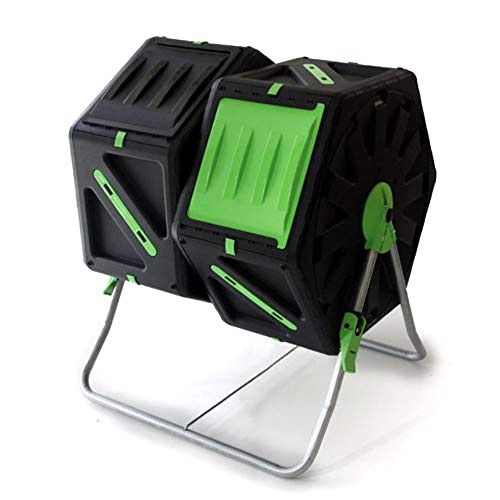
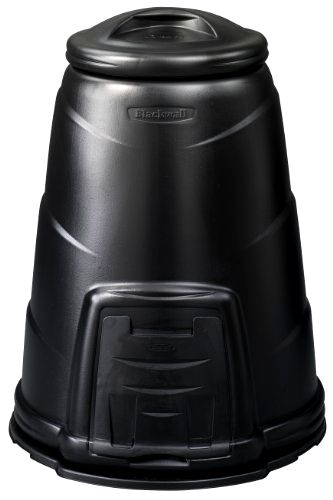
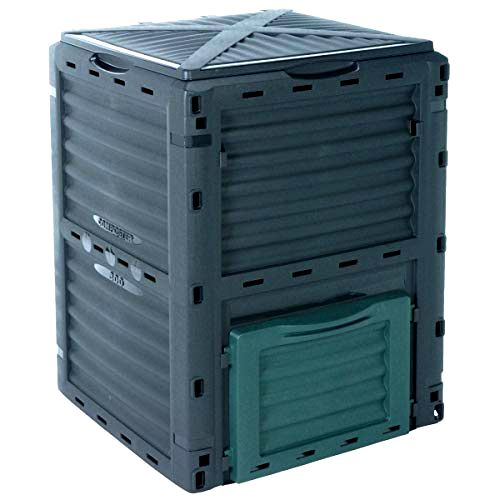
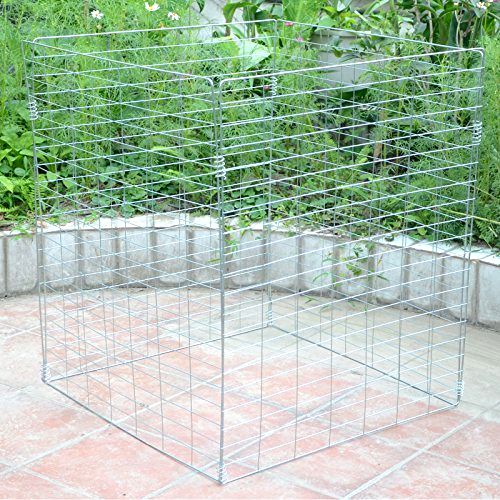
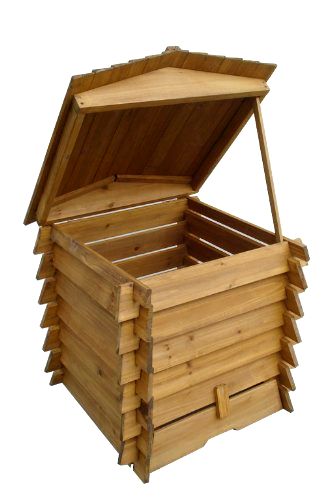
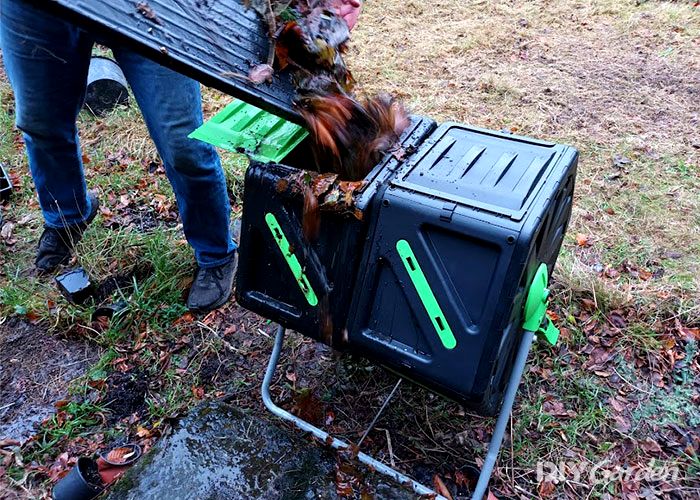
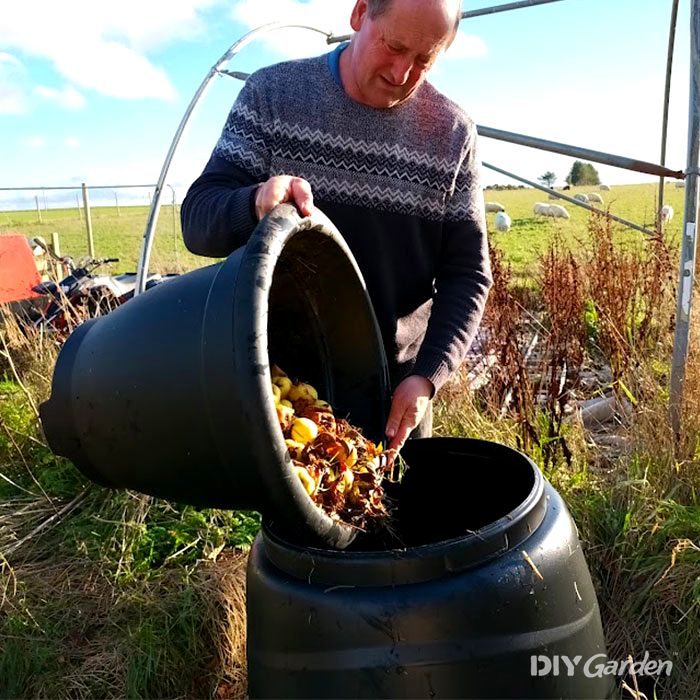
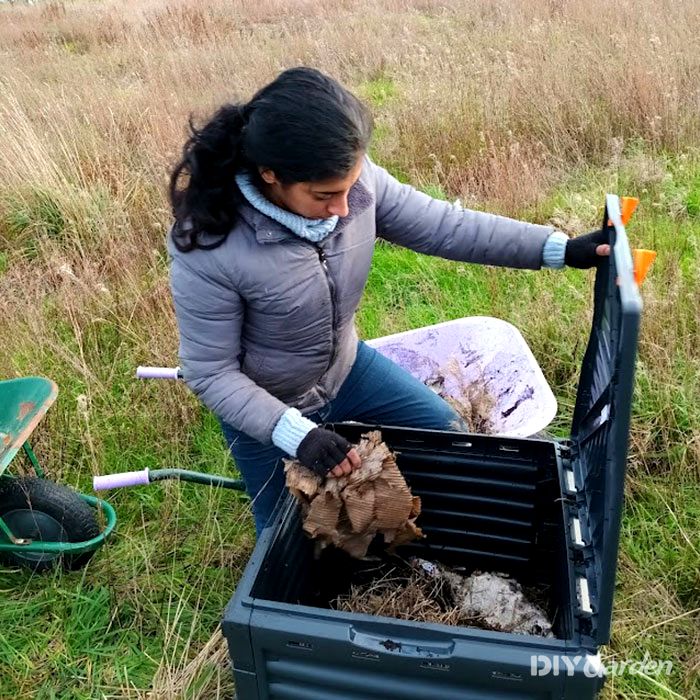
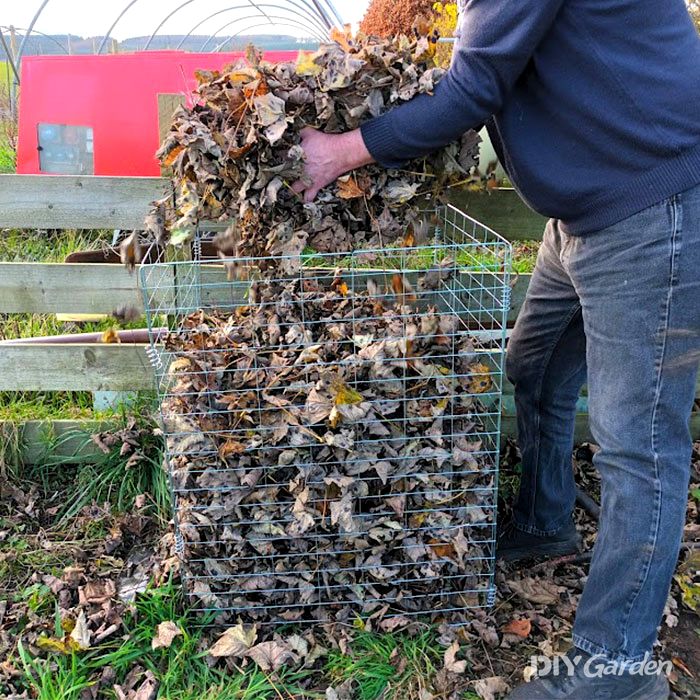
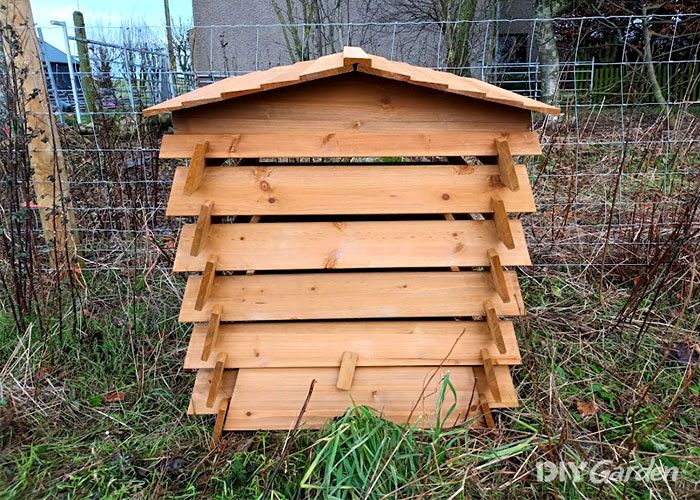

Share